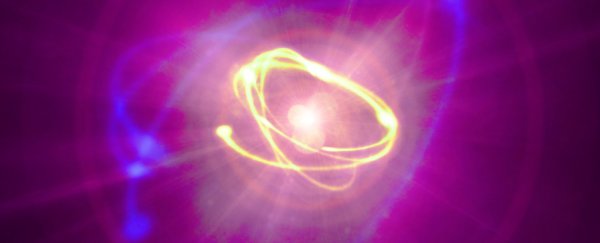Something about atoms has never added up. Fundamental particles called quarks get kind of sluggish once they're caught up in crowds of protons and neutrons – and quite frankly, they shouldn't.
For decades, physicists have hunted for clues on the quark's tendency to slow down in larger atoms, but have come up empty-handed. But now, a closer look at old data has finally revealed a clue to explain this strange phenomenon.
A massive team of physicists known as the CLAS Collaboration (after the CEBAF Large Acceptance Spectrometer) recently ran through data gathered from previous experiments at the Jefferson Lab's Continuous Electron Beam Accelerator Facility.
Their goal was to find evidence to support one of two potential explanations for why the fundamental units that form protons and neutrons – a family of particles called quarks – have less momentum inside larger atoms.
The phenomenon was first noticed by the European Muon Collaboration in the early 1980s, who observed a difference in how nuclear particles behaved while bound inside large atoms like iron, compared to smaller ones like hydrogen.
In what came to be known as the EMC effect, it quickly became clear that the bigger atoms got, the more sluggish their quarks became.
Quarks are fairly high-energy particles though, making them divas when it comes to sharing the stage. Once bound as triplets to form protons or neutrons, it shouldn't make a difference whether the quarks are in a nucleus or running free through the wild yonder.
"There are currently two main models that describe this effect," says Douglas Higinbotham, a nuclear physicist from Jefferson Lab.
"One model is that all protons and neutrons in a nucleus [and thus their quarks] are modified and they are all modified the same way."
Another explanation suggests the answer lies in some sort of short-range relationship that pops up briefly when different groups of quarks come within range.
"It says that many protons and neutrons are behaving as if they are free, while others are involved in short-range correlations and are highly modified," says Higinbotham.
By analysing old data on the scattering of electrons bouncing off protons and neutrons inside atoms of carbon, aluminium, lead, and iron, the researchers were able to come up with a universal function that describes the EMC effect.
Their description relies on the chance of a brief short-range relationship between a neutron and a proton as they touch.
"Now we have this function, where we have neutron-proton short-range correlated pairs, and we believe that it can describe the EMC effect," says physicist Barak Schmookler, now a researcher at Stony Brook University in the US.
This supports the second model that says quarks act differently only under certain circumstances, such as when the right combination of proton and neutron snuggle up more closely than usual. Otherwise the nuclear particles and their quarks act as free agents.
In quantum physics terms, this intimate affair is a compatible overlap in structure that gives each set of quarks a little more freedom to roam. Increase the space a particle can be found in, and you decrease the momentum it can have.
"In quantum mechanics, anytime you increase the volume over which an object is confined, it slows down," says Axel Schmidt, a postdoc student at MIT's Laboratory for Nuclear Science.
"If you tighten up the space, it speeds up. That's a known fact."
This universal function neatly explains why quarks slow down more in bigger atoms. With more neutrons in the local area, each proton has a greater chance of finding love. So to speak.
It also means we can ditch the old idea that this loss of momentum is a core characteristic of quarks as they gather inside large nuclei.
"The picture before this model is that all protons and neutrons, when they are stuck together in a nucleus, all of their quarks start to slow down," says Schmidt.
"And what this model suggests is that most protons and neutrons carry on like nothing's changed, and it's the select protons and neutrons that are in these pairs that really have a significant change to their quarks."
The discovery isn't quite enough to definitively close the book on this mystery, though. Follow-up experiments at Jefferson Lab will provide details on how protons move in the far less-crowded nuclei, deuterium – the proton-neutron flavour of hydrogen atoms.
For now, however, it's a fairly convincing explanation for the EMC effect, and one that adds a tiny bit of detail to the dance party at the heart of nuclear physics.
This research was published in Nature.
